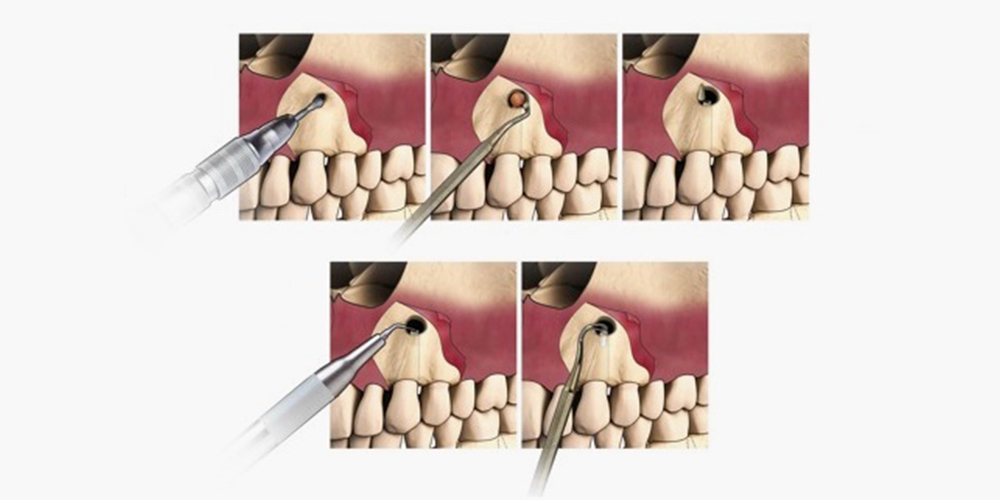
What is Apicoectomy? Is it Successful?
What is Apicoectomy?
Apicoectomy, also known as apical resection, is an oral surgical procedure that involves the removal of the root tip and the cleaning of infected tissue. This procedure is typically performed when root canal treatment has failed, and lesions persist at the root tip. The main goal is to prevent bacterial leakage from the root canal system into the periradicular tissues. To achieve this, a portion of the root tip is removed, and the area is sealed with a root-end filling. Apicoectomy is often considered the last treatment option before tooth extraction and, when performed correctly, can help preserve the natural tooth.
Apicoectomy is generally recommended for teeth that have undergone endodontic treatment but have not healed properly or have become re-infected. During the procedure, infected tissue at the root tip is carefully removed while preserving as much healthy tissue as possible. This surgical intervention offers a significant advantage for patients looking to avoid tooth loss.
Why is Apicoectomy Performed?
The primary reason for performing an apicoectomy is to eliminate persistent infections and recurring lesions. The root tip contains lateral canals, cracks, and anatomical voids where bacteria can colonize. Since this area is difficult to clean with standard root canal procedures, removing the root tip by approximately 3 mm and sealing the area with a biocompatible material is recommended. This helps to prevent bacterial leakage and ensures the long-term health of the tooth.
In some cases, small infection sites near the root tip may heal naturally after root canal treatment. However, in certain cases, the infection can become chronic, spreading to surrounding tissues. Apicoectomy is an effective solution for managing these persistent infections.
Who Can Perform The Procedure?
This procedure is performed by experienced dentists, endodontists, or oral surgeons. Since apicoectomy is a surgical procedure, the expertise of the practitioner and the quality of the equipment used play a crucial role in success. Modern technologies such as microscopes, high-intensity lighting, and ultrasonic instruments help improve the precision and effectiveness of the procedure.
How is It Performed?
The apicoectomy procedure is carried out step by step as follows:
- Local anesthesia is administered to numb the area, ensuring that the patient does not feel pain during the procedure.
- The gum tissue is lifted to access the infected area, and the affected portion of the bone is cleaned.
- The root tip is trimmed by approximately 3 mm, and the area is sealed with a special root-end filling to prevent bacterial reinfection.
- The treated area is filled and sealed to support the healing process.
- Sutures (stitches) are placed to close the gum tissue, and the area is carefully sterilized.
- After 7-10 days, the stitches are removed, and a follow-up examination is conducted to monitor healing.
Is The Procedure Painful?
No, apicoectomy is not a painful procedure. Since the procedure is performed under local anesthesia, the patient does not feel any pain. To enhance the success of the treatment, microscopes, lighting, and ultrasonic instruments are commonly used. Some mild discomfort or swelling may occur after the procedure, but this is temporary and can be managed with proper post-operative care.
When is an Apicoectomy Necessary?
- When root canal treatment has failed, and blocked canals cannot be reopened, causing persistent pain
- When a previously treated root canal becomes re-infected or develops a recurring lesion
- When there is a perforation (hole) in the root
- When a broken instrument or excess root canal filling material needs to be removed from the root tip
- When a cyst is present at the root tip
When is an Apicoectomy Not Recommended?
- If the root is too close to anatomical structures such as nerves or sinuses
- If the root length is insufficient, and removing a portion would compromise the tooth’s stability
- If the tooth has a vertical fracture (crack extending through the root)
- If the tooth is beyond repair and cannot be restored
- If the patient has systemic health conditions that make surgery risky
Is Apicoectomy Successful?
When performed on the right cases and executed by skilled professionals using modern equipment, apicoectomy has a success rate of 86-90%.
- Lesions smaller than 5 mm typically heal within a few months.
- Larger lesions may take a few years to fully heal.
- Apicoectomy has a lower success rate for molars compared to front teeth.
Post-Apicoectomy Care Instructions
- Apply cold compresses immediately after surgery to reduce swelling.
- Avoid brushing the surgical site aggressively to prevent irritation.
- Refrain from consuming extremely hot or cold foods and beverages.
- Do not smoke or use tobacco products, as they can hinder healing.
- Minimize excessive lip movements, which may loosen the stitches.
- Gargle with warm salt water to keep the area clean.
- Take prescribed medications as directed by your dentist.
Cost of Apicoectomy in 2025
According to the 2025 Turkish Dental Association (TDB) fee schedule, the cost of an apicoectomy varies based on the number of roots involved, ranging from 250 to 300 Euros. If additional root canal retreatment is needed before the apicoectomy, or if specialized materials are used for root-end sealing, the total cost may increase.
For a detailed consultation and treatment planning, visit or set an online consultation with FineUp Clinic in Istanbul.
